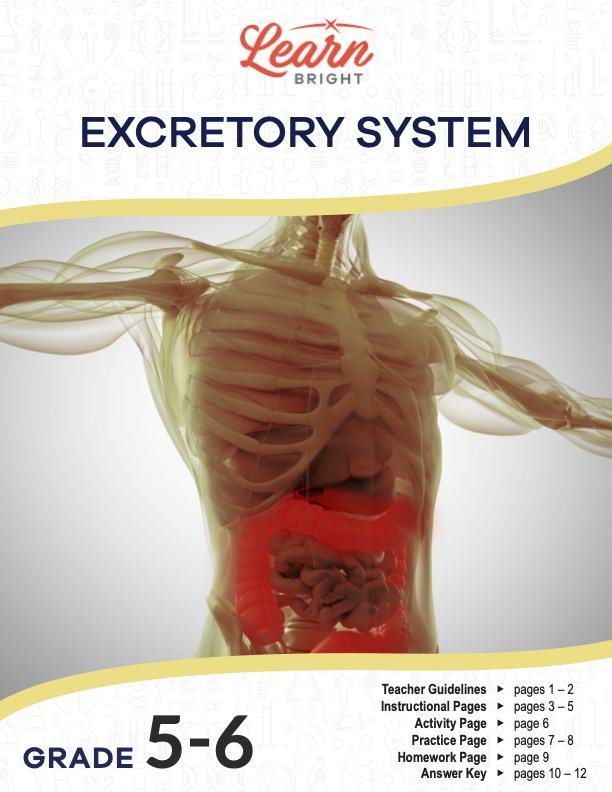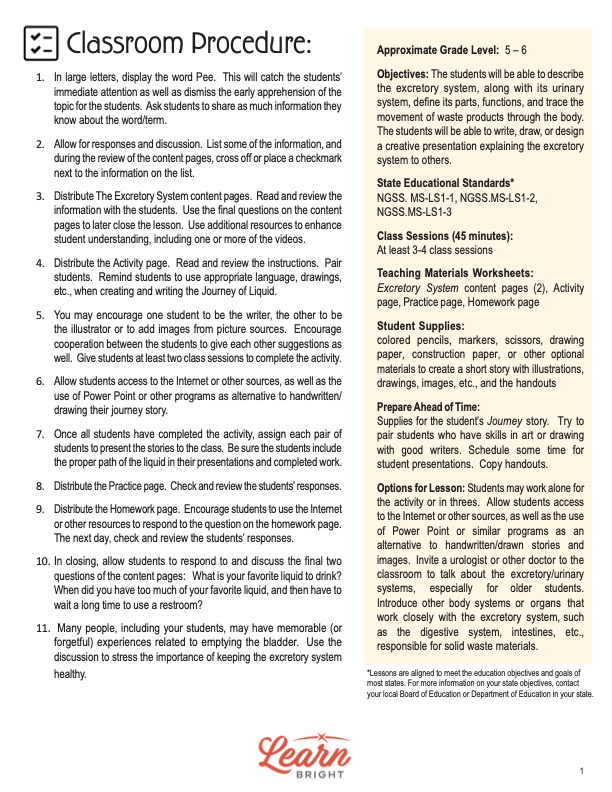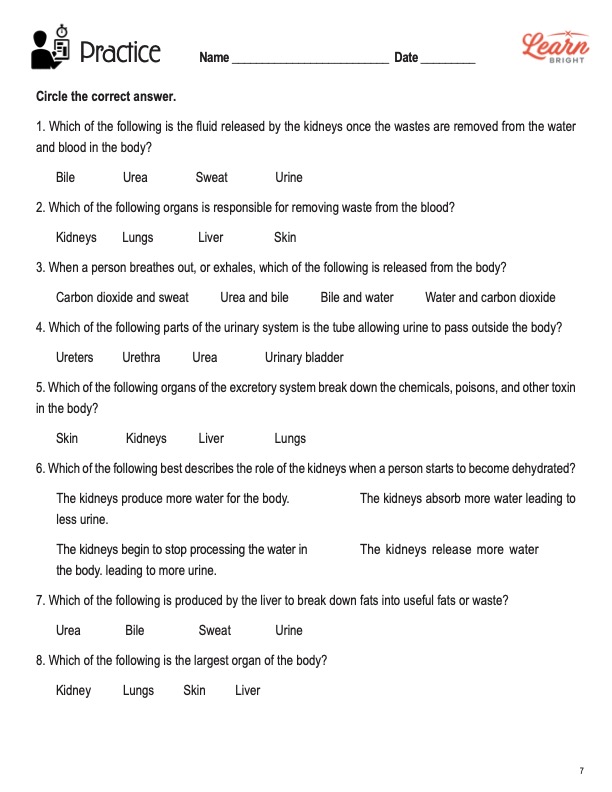Description
What our Excretory System lesson plan includes
Lesson Objectives and Overview: Excretory System explores the functions of the parts that make up this body system, including the urinary system. Students will discover how these parts work together to move waste product through the body. They will also learn about how different parts of the body excrete different waste products. This lesson is for students in 5th grade and 6th grade.
Classroom Procedure
Every lesson plan provides you with a classroom procedure page that outlines a step-by-step guide to follow. You do not have to follow the guide exactly. The guide helps you organize the lesson and details when to hand out worksheets. It also lists information in the yellow box that you might find useful. You will find the lesson objectives, state standards, and number of class sessions the lesson should take to complete in this area. In addition, it describes the supplies you will need as well as what and how you need to prepare beforehand. For this lesson, you will need a number of supplies for the students for the activity portion in which they will create stories to present to the class. These materials include colored pencils or markers, scissors, drawing paper, construction paper, and any other materials you think students might want to use.
Options for Lesson
There are several suggestions in the “Options for Lesson” section of the classroom procedure page for additional ideas or activities that you could incorporate into the lesson. As an alternative to a handwritten/drawn presentation, students could create and present their story for the activity digitally using slideshow software or similar programs. Another suggestion is to invite a urologist or other doctor to speak with students about the topic. One more idea is to introduce students to additional body systems and organs that work closely with the excretory system, such as the digestive system and the intestines.
Teacher Notes
The paragraph on the teacher notes page provides a little extra information on what to expect from this lesson plan. It reminds you of the main objective of the lesson and about the possibility of issues relating to the maturity of students given the nature of the lesson’s subject matter. Keep this in mind as you prepare, and use the blank lines to write out thoughts and ideas as you plan.
EXCRETORY SYSTEM LESSON PLAN CONTENT PAGES
What Is the Excretory System?
The Excretory System lesson plan contains a total of three pages of content. The lesson first describes how people drink lots of different liquids, from water to juice to milk. It explains that liquid exists even in solid foods. Students will learn where food goes and what happens once the body finishes processing it.
The excretory system is responsible for controlling all the fluids entering and leaving the body. Throughout this process, the system removes excess and unnecessary fluids from the body. The organs that play a role in this system include the kidneys, lungs, liver, and skin. Each of these components has some responsibility in the process, but the kidneys are the main organs within the system.
In addition to these organs, the urinary system is a component within the excretory system. It controls the balance of water and chemicals in the body to ensure it functions properly. It works with the lungs, kidneys, and intestines. The urinary system also produces, stores, and eliminates urine released by the kidneys. A few other parts of the excretory system include the ureters, bladder, and urethra.
Parts of the System
The lesson provides a diagram of the kidneys connected to the ureters, urethra, and bladder. Each part of the diagram has a box with an explanation for the responsibilities of that part. The kidneys are two bean-shaped organs that rest below the ribcage in the middle of the back. They remove various types of waste from the blood. Excess waste moves to other parts of the excretory system, such as the ureters.
The ureters are thin tubes that connect the kidneys to the urinary bladder. The bladder is a hollow, balloon-shaped organ in the pelvis that can stretch to store up to around 16 ounces of fluid. When a person’s bladder fills, they normally must urinate to eliminate the waste through the urethra. Like the ureters, the urethra is a tube through which the body releases urine.
In addition to removing waste, our kidneys also help control the water our bodies need for survival. They are important because they ensure we remain hydrated. For instance, if a person gets stuck in the middle of a desert without water, their kidneys will absorb more of the water in their body, resulting in less urine. Because of the smaller supply of urine, their body will retain more water and stay hydrated for longer.
Lungs, Liver, and Skin
Other important components of the excretory system include the lungs, liver, and skin. Our lungs thin out carbon dioxide from the blood and allow it to enter into the lung tissue. When we exhale, our lungs release both carbon dioxide and water. The carbon dioxide is a waste product that our bodies have to eliminate.
Another organ is the liver, which breaks down chemicals, poisons, or other toxins that enter the body in one way or another. It produces bile that breaks down fats into useful fats or waste. In addition, it produces urea, which is a waste product from toxic substances that the body releases through urine or sweating.
Skin is the largest organ in (or on) a person’s body. It provides protection and eliminates sweat that contains waste such as urea, salts, and water. This sweat helps cool the body down. It is important to keep the skin clean to help ensure it functions properly.
Students will learn that there is a nerve on the bladder that informs the brain that the bladder is full. This is the point at which someone would ask to be excused to use the restroom. A muscle keeps the bladder closes. A different nerve tells the bladder to open. This is one way that students will see how all the body’s systems work together to keep them healthy.
Urinary System and Issues
On the last content page, students can review a more detailed diagram of the components of the urinary system. These include the kidneys, ureters, bladder, urethra, and nerves. When a person has problems with their excretory system, the kinds of symptoms they might experience vary. They might feel a burning sensation when they urinate, have to urinate frequently, or feel like they have no control over urination at all. When these things occur, it is important to seek medical help. Such symptoms can signify infection or more serious problems, like kidney stones.
A kidney stone is a buildup of calcium and other compounds that makes its way through the urinary system and causes intense pain. The lesson provides a graphic of different types of kidney stones within a kidney. These include calyceal, renal pelvic, and upper ureter stones. The type of stone depends on where it develops within the kidney.
Students will learn that keeping their excretory system healthy is important. To do so, they should do things like drink plenty of fluids, exercise often, and seek help if they have any trouble urinating. At the bottom of this page is a callout asking students a couple questions that could open the class up to a discussion.
Key Terms
Here is a list of the vocabulary words students will learn in this lesson plan:
- Excretory system—the body system that controls all the fluids entering and leaving the body
- Urinary system—the body system that controls the balance of water and chemicals in the body to ensure proper functioning
- Urine—the liquid that kidneys release that exits the body through the urethra
- Urinate—to eliminate waste through the urethra
- Kidney stone—a build-up of calcium and other compounds that travel through the urinary system and cause intense pain
EXCRETORY SYSTEM LESSON PLAN WORKSHEETS
The Excretory System lesson plan includes three worksheets: an activity worksheet, a practice worksheet, and a homework assignment. Each task will reinforce students’ comprehension of lesson concepts and help them demonstrate their knowledge in different ways. Refer to the guidelines on the classroom procedure page to determine when to hand out the worksheets.
STORY TIME ACTIVITY WORKSHEET
Students will work with a partner to write a story from the perspective of a drop of liquid on a journey through the excretory system. The journey must include information about the organs that are part of the system and their responsibilities. Students can choose the type of liquid for their drop. They should include illustrations, drawings, or images from the internet or other sources. In addition, part of the story should be about the drop’s path before it entered the body. All of the stories should have a title, and students can be as creative as they want as long as the information is correct. After everyone finishes, they can present their stories to the class.
EXCRETORY SYSTEM PRACTICE WORKSHEET
For the practice worksheet, students will review 15 questions. They must circle the correct option from the four choices available. There are two pages total for the practice worksheet. If you want to make this a quiz, you can restrict students from referring to the content pages.
LABEL THE DIAGRAM HOMEWORK ASSIGNMENT
The homework assignment has two parts. The first part requires students to label the parts of the excretory and urinary system using the terms in the word bank. For the second part, students will research and respond to a question about what things they can do help keep the excretory system healthy.
Worksheet Answer Keys
The last couple pages of the document are answer keys for the practice and homework worksheets. The correct responses are in red to make it easy for you to compare them with students’ work. The only question that should yield any variation is the final prompt of the homework assignment. If you choose to administer the lesson pages to your students via PDF, you will need to save a new file that omits these pages. Otherwise, you can simply print out the applicable pages and keep these as reference for yourself when grading assignments.









